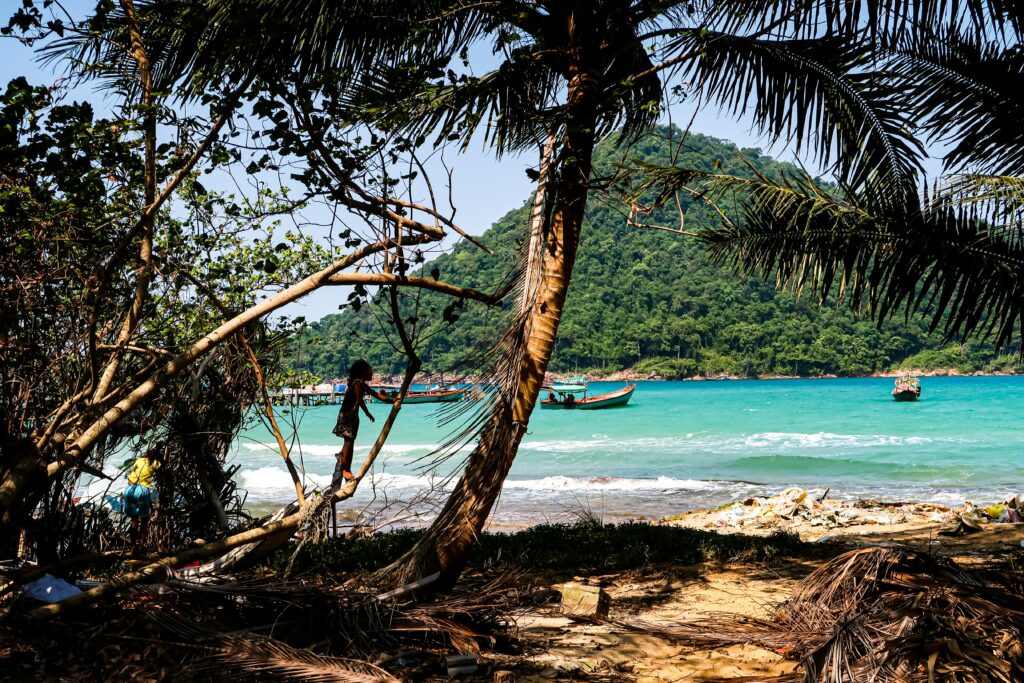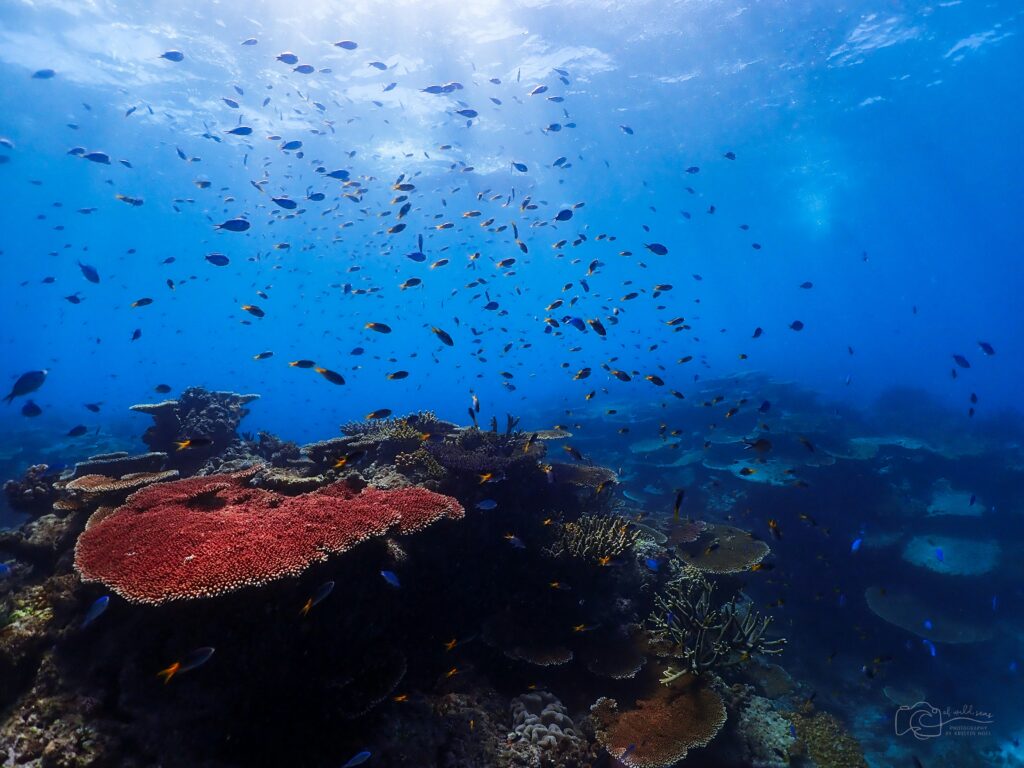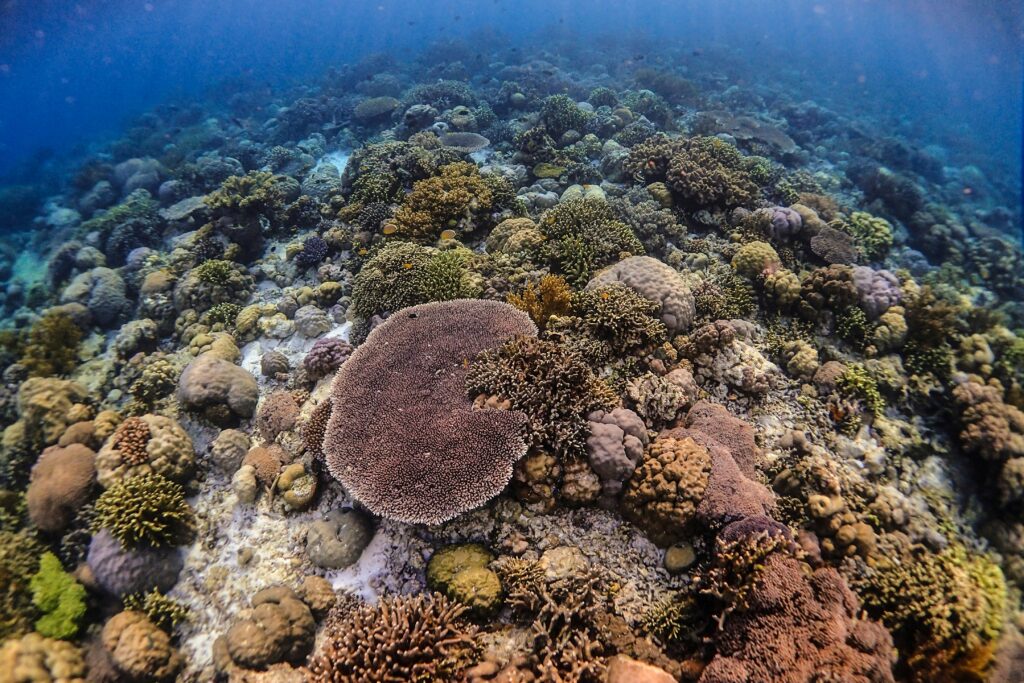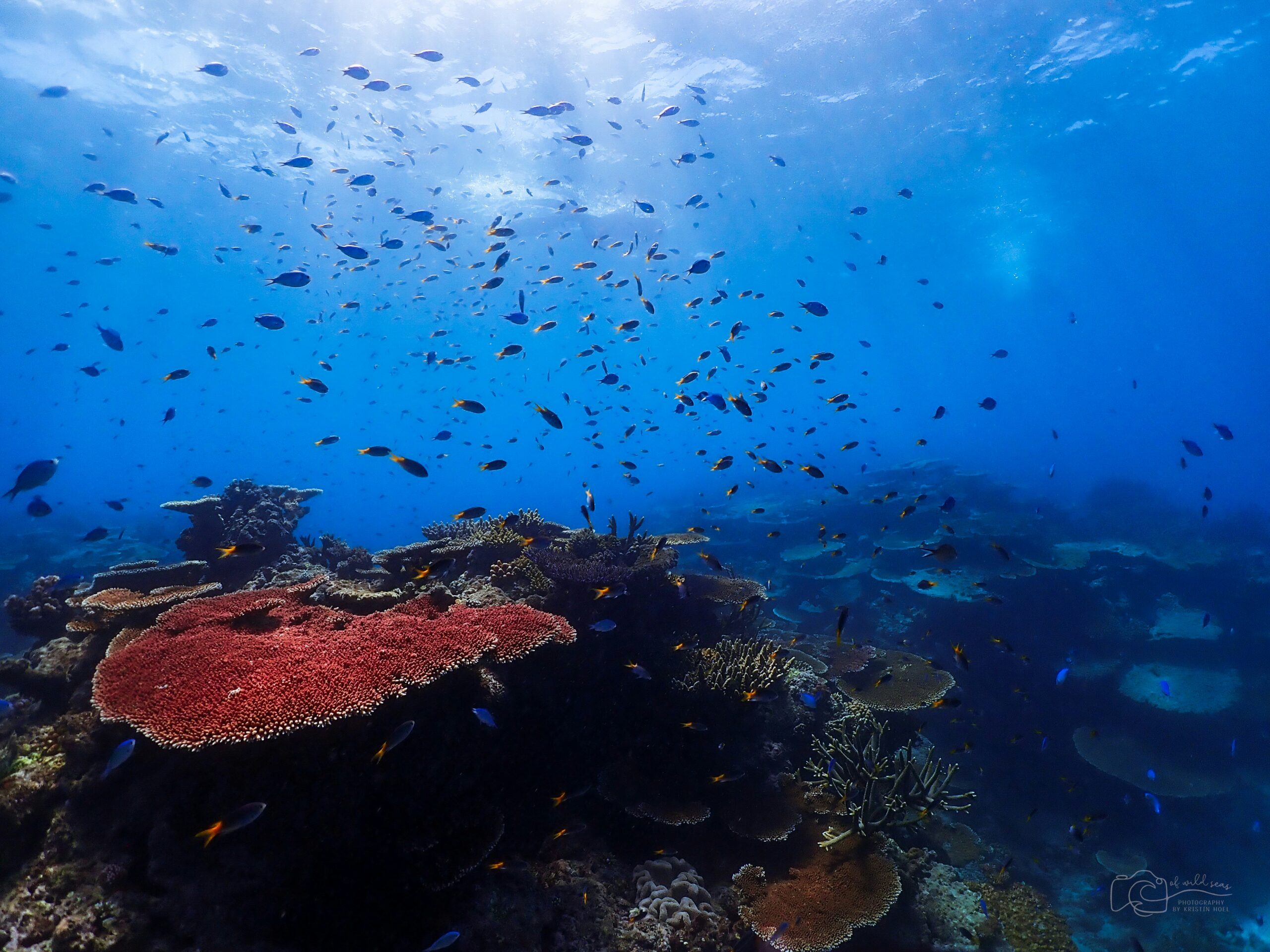Sailing to the dock of the bay
It’s hard to describe the image of sailing into M`Pai bay without touching on every discernable cliche of an island paradise. But as we step over gently lapping waves from the boat onto a rickety wooden dock, there’s small tropical fish visible through the planks in the crystal water beneath.
Looking up towards the beach, a stretching crescent of white gold sand is dotted by small buildings of wood and pastel coloured stucco. Past swooning palm trees and sandy grasses lies a dense jungle, as the island’s interior rises into forest covered hills. We’re on the island of Koh Rong Sanloem, Cambodia, where the sea shines by day and glows by night.
Koh Rong Sanloem is an island located off the southeast coast of Cambodia. With several picturesque beaches and lush jungle, the surrounding waters are rich in marine biodiversity, making the area an excellent destination for snorkelling and diving enthusiasts. Koh Rong Sanleom is reached by ferry from Sihanoukville, a once quaint town that is now a humdrum city hosting tired casinos and drab high-rise hotels.
Koh Rong Sanleom is smaller and currently less developed than its neighbour Koh Rong, although the mechanical wheels of the tourism industry are turning with increasing speed. Tracks of cleared forest can be seen on the boat approach, torn up to make way for roads on an island which currently has none. Around the island, a handful of luxury hotel complexes are having their sites cleared and foundations dug.
We’re staying at a hostel called The Cliff, a small teakwood bastion balanced on a rocky pinnacle above a sheer cliff face, boasting an unbroken view for miles over the gulf of Thailand. The Cliff Hostel is regarded as a socially responsible local business, claiming a stay with them benefits sustainable development projects for the local community.

First dip
Apart from slowing down to island tempo, forgetting the rest of the world exists and napping in the sun with a 1 dollar beer, the big draw of Koh Rong Sanleom for many is the snorkelling, diving and marine life. Whilst setting down bags, Felix who checked us in, offers up the phrase “If you’d like to come on the plankton walk tonight, we’ll meet at 7:30 at the bar” without more explanation, he’s out of sight and heading back to work.
For now it’s still late morning and a hidden highlight of The Cliff Hostel is a dizzyingly steep, stone staircase, which winds down 100 metres or so from the cliff top bar, right into the sea.
Gingerly descending down the snaking stairs, the turquoise sea below gently foams as it greets the rocks. After climbing down past flowering shrubs, buzzing insects and skittish lizards disturbed of their sunbathing, a small shimmy over boulders made sharp from barnacles is needed to enter the water. For the less faint hearted, a plunging dive into depths over the rocks results in less scratches.
Mask and snorkel donned, the first glimpse under the waves reveals an ethereal world, the late morning sun glances in at an angle to scintillate the silt stirred up by the tide. A thriving reef community, abundant in many fish species is immediately seen, as schools of sergeant fish pass neon coloured wrasse, blue and yellow damselfish zigzag around a slow moving parrotfish, all above their technicoloured cityscape of coral and rock.
Amongst banqueting sized table coral and monolithic brain corals, there’s foreboding black, white and purple urchins, some the size of basketballs, hunkered in the cracks. Electric blue lips of a giant clam gently purse as various sargassum and soft corals sway in the current.
Continuing to follow along the reef at the foot of the cliff, shoals of striped damselfish and tangfish keenly peck at algae on the rocks, a previously unseen goby shuffles from one perch to the next and a small group of moorish idols drift by.
Looking out to deeper water, what’s seemingly a cloud of silt breaks apart with dazzling flashes of silver as a shoal of scad are spooked, whilst further still, silhouettes and shadows against the endlessly deep blue set the heart racing for stories of barracuda and sea snakes.

A glowing sea
Returning to shore after a fruitful first swim, we explore the M’Pai bay area of the island, small crabs amble sideways over dry palm leaves and white rump shama hop amongst the scrubby beachside vegetation. We find ourselves back at the hostel and eager to learn more about the previously mentioned plankton walk. Heading to the bar area at 7:30pm we meet a small group of people who seem equally as bemused as to what is about to happen.
A request for phone lights to be shone on the ground is passed around the group as we set off down the hill, there’s no lighting on any of the paths and trails and by 7:30pm, the night is pitch black. As we’re making our way down the dirt road, Felix from the hostel is explaining that the sea surrounding Koh Rong Sanleom is full of bioluminescent plankton.
This was totally new information to us and had slipped through the net of our information gathering prior to coming. As we stroll by torchlight to the beach in the warm night air, scenes of a lambent blue sea, incandescent under the moon are being painted in our imagination.
Making our way along the beach, there’s no sign of anything aglow in the water, believing we must have to carry on until a certain bay or cove, we stop by a tree. We’re given snorkelling masks and told we’ll be fine to hang our t-shirts and bags here. Slightly perplexed by a distinct lack of bioluminescence, as well as the prospect of wading into the sea in the black of night, we head towards the sound of gentle breaking waves.
The water on the beach is almost bath temperature and helps to calm any anxieties of swimming at night, we slowly head deeper from ankle to knee. Continuing to become more submerged, the dark feels as though it’s playing tricks on our eyes, as glimpses of static fizz in our lower peripheral vision.
As the water gets deeper, it starts to become clear, the movement of any body part in the water is highlighted by a quickly dissipating sparkle of neon blue, the final twinkling remnants of a firework shooting off into the darkness. It’s now that Felix explains, this is the microscopic plankton, this is their survival mechanism in action.
When disturbed mechanically, for example, by a lunging predatory fish, hundreds of the tiny organisms emit a bright blue-green light and rapidly break away in every direction. The resulting flash and burst of movement confuses the predator allowing the plankton to escape, perhaps sometimes even attracting a bigger fish for which the plankton’s predator will need to escape.
For us, now masks on and waving manically in the water, the display is mesmeric. Flicking a wrist with open fingers through the water causes a drag of what looks like pure energy to radiate from our digits. A path of a whole arm movement is traced with glistening magic particles, fading from sight as quickly as they emerge.
The group spends at least half an hour in the water before the astonishments start to settle, the whole time a curious, almost uncomfortable whole body tingling sensation comes and goes, as Felix says were being bitten by a cloud of hundreds of tiny plankton.

Leaving Koh Rong Sanleom
We’re able to process the amazement of the experience on the walk back to the hostel, anticipating dreams this night we be ablaze with iridescent diamond dust. The next few days are spent snorkelling, hiking to other parts of the island and remedying sandfly bites.
Ko Rong Samleom has been a picturesque, nature filled escape, but the spectre of development and over-tourism looms in the background. We’re always aware that as travellers we’re part of an increasing problem and that sustainable choices need to be made at both the consumer and developer level.
A fragile idyll such as Ko Rong Samleon is threatened with deforestation, habitat loss, coral bleaching and sadly, like many parts of Cambodia, pollution from plastic trash and wastewater.
Low impact hostels, bungalows and guesthouses such as those found around M’Pai bay at the time of visiting, feel just about blanched in a world which now almost totally relies on tourist income, but could equally become undone by too much of it.
The sound of a wave lapping against posts of an old wooden pier sits in stark contrast to the powerful diesel engines of bulldozers and earth-movers, shifting the soils of Koh Rong Samleon into an uncertain future.

